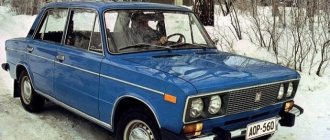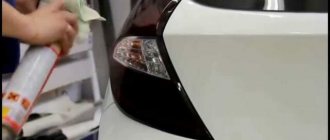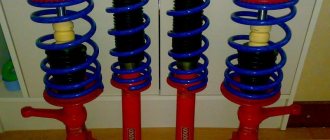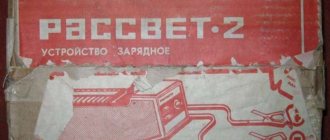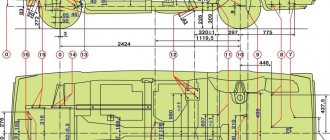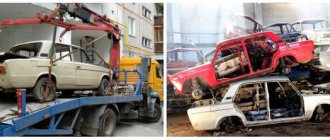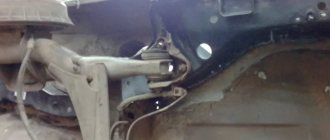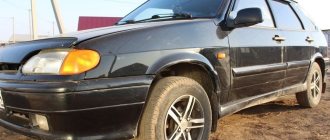Body repair of VAZ 2106
Do-it-yourself body repair of a VAZ 2106 is caused by the desire to restore the vehicle after an accident or damage of varying severity. On the VAZ 2106, body repairs are carried out according to the instructions. The car owner is recommended to first familiarize himself with the types of body work, their nuances, learn more about the applicable tools, and so on.
Types of body repair
Body repair of VAZ 2106 has the following types:
- Redecorating. The paintwork and bumpers are restored, scratches, chips and areas of corrosion are eliminated.
- Treatment of internal cavities. Spars, sills, door and luggage niches are difficult to access for anti-corrosion treatment. To prevent parts from rusting, they are treated with special protective agents.
- Car underbody treatment. The working surface is covered with special protective mastics.
- Removing dents. To level the dented area, various impact pads, spoons, hooks, suction cups and reverse hammers are used.
- Major body repairs. It is carried out in case of violation of the geometry of the vehicle body, excessive damage to the paintwork, or the presence of a large number of dents, chips and scratches. Also, major repairs are necessary when corrosion has spread to more than 50% of the surface area of the vehicle body.
When carrying out restoration work, the specifics of the car body are taken into account.
Increasing body rigidity
It is possible to strengthen the body of a VAZ-2106 by installing special spacers (available for sale) on the front and rear parts of the car. When purchasing, you need to pay special attention to the dimensions so that they fit the mounts. After installing the so-called spacers, the car will acquire noticeable additional rigidity, and with it, reliability in handling. It is also possible to install only on the front part, due to the complexity of mounting on the rear.
Working with the bottom
If the bottom requires repair, then this cannot be delayed. Since corrosion can affect even fresh metal. Of course, such work can be entrusted to a professional, but there is not always money for this. There are two ways here: welding the bottom or laying sheets of iron with additional coating with mastic.
If you still decide to go with the second option, then you need to buy several sheets of iron (galvanized), special mastic and fastening materials. Then prepare the car for this. We remove everything unnecessary from the car interior (seats, insulation). Then we clean everything down to the hardware. And we begin to actually transform the bottom. To do this, you need to remove the rust and apply new sheets (prepared to size) below and above. Be sure to coat everything thickly with mastic. We fasten the iron with self-tapping screws. It is recommended to apply iron sheets in several layers, each one treated with mastic. Upon completion of the work, we restore the completeness of the interior in the reverse order. A floor tuned in this way will still serve.
Body work
This type of work is necessary when the car has dents, chips or other defects that spoil the appearance. Of course, such mechanical damage requires straightening out dents, puttying and, of course, painting the car. If you have all of the above skills, this will significantly save your family budget. Before painting, you can replace the front and rear headlights or tint them. And it’s a good idea to replace your original bumpers with more modern ones.
Specifics of the VAZ 2106 body
The Lada sixth model has a sedan body type; it consists of a main load-bearing all-metal frame and various attachments. The units and parts that are installed on models from the classic series are made using the stamping method and are connected to each other by welded seams.
The body includes the following parts: engine frame, front fenders, roof, floor panels, left and right side panels. The front and rear bumpers of the car are chrome-plated; they are attached to the body using special brackets. The trunk and hood are quite bulky.
As for the doors, they are made of two panels: outer and inner, they are connected by welding. Both front and rear doors have the same type of attachment to the body.
Six models produced in the mid-90s and early 2000s have thinner body metal compared to cars produced between 1976 and 1990.
Transmission and chassis repair 2106
Old VAZ 2106 drum brakes do not need to be replaced with disc brakes
The chassis, despite the fact that it is structurally more than half a century old, does not irritate with its archaism. If you look at it, even antediluvian drum brakes do not require replacement with disc brakes. They cope well with the car at the speeds that are available to it, and if the brake pads are replaced in a timely manner, they do not cause any complaints. The condition of the steering gear is assessed both while driving and during repairs, but its maintenance consists only of changing the oil. It is extremely rare for the steering mechanism to jam, and this happens when the driver missed the moment of lubricant leakage, and it can leak in the place where the steering column is attached to the mechanism shaft.
The gearbox of old Zhiguli cars amazes with its reliability and durability. There are examples of sixes whose owners do not know what gearbox repair is. As a rule, these are cars that have never seen Castrol or Shell oils, and only transmission TAD 17 was poured into the box, but according to the regulations.
If you treat yourself well, the VAZ 2106 will show what a classic rear-wheel drive layout is capable of, and if you treat the car with all your heart, then this oak tree will make noise for decades to come.
Tools
To carry out work on restoring the body of the “six”, we will need the following set of tools:
- A set of hammers of different types and weights. Rubber mallets and percussion instruments with a grooved working surface.
- Special hooks.
- Reverse hammers.
- Impact spoons.
- Jack.
- Anvils and substrates of various shapes and sizes.
You should also stock up on 8 and 22 wrenches, as well as a screwdriver. You will need these tools to remove body parts such as bumpers or trim moldings.
Straightening
It is the straightening that should be given more attention if the body of the “six” needs to be given its original appearance.
What does the word "straightening" mean? It is translated as alignment. As mentioned above, body straightening is considered the main work and its goal is to restore deformed areas or the entire body.
Carrying out straightening, as is known, involves a special technique. It is done efficiently and quickly. The goal is to stretch out or straighten concave parts of the body. If the person doing the straightening has little experience, it will be very difficult for him to cope with the work.
On the other hand, thanks to modern technologies, even a beginner can cope with straightening. What does a pneumatic hammer cost, allowing you to quickly bring a body part back to normal.
Common tools for straightening: hammer and jack. Here's how the main stages of straightening are carried out:
- First the paint is removed;
- The area is being straightened;
- The area is puttied and rubbed.
Note. Some experts recommend heating up body parts to make the straightening effect even better. Only in this case it is necessary to control the process, otherwise the metal will overheat and may even melt.
Another secret to straightening: if the dent that needs to be leveled is small, then it is recommended to straighten it from the middle. On the contrary, if the dent is large, it is leveled from the edges.
In addition to a hammer and a jack, to carry out this operation yourself, you will have to arm yourself with the following tools:
- A spotter used for spot welding;
- Hammers of different types: inertial, reverse and with a sharp striker;
- Notching block.
Recently, it has become popular to carry out vacuum straightening. This procedure allows you to eliminate bruises on a metal surface many times faster. Vacuum straightening is carried out using special suction cups.
Note. This type of straightening is suitable for large dents, but if there are scratches on the surface, this method is not recommended.
Process technology
The VAZ 2106 body is straightened immediately before painting the restored part:
- The surface to be treated is cleaned of dirt, washed, dried and degreased. Remove old paint from the working surface.
- Use frequent gentle blows of a hammer to smooth out the dent. If the defect is deep, then the process is performed from the edge of the damage, and gradually moves towards its center. Metal substrates are placed on the reverse side of the area to be restored. They must have the appropriate shape.
- Metal breaks are repaired using a welding machine. Next, the weld is ground.
- The area restored from damage is covered with putty. It levels the work surface.
- The putty part is sanded and painted.
The putty should be applied in a thin layer. Otherwise, the paint will become covered with numerous cracks and begin to fall off.
DIY body repair
VAZ 2106 car body
Repairing the outer tail of a car must be taken very seriously, because such repairs are the most expensive, but at the same time it is the most important work on the vehicle. After all, the appearance of a car is directly related to the degree of its grooming. Here, a lot depends on how to carry out this type of repair of the VAZ 2106 body - with your own hands or at a service station. In a broad sense, such body repair is the restoration of paintwork, as well as the original geometry of the body, deformed due to an accident. If there are shallow dents and irregularities on the elements of the body part, repair using the classical method involves treating the damaged area with sandpaper with a fine abrasive, applying putty with a special tool to give the surface a uniform level throughout. But with a dent of small depth, you can use the method of paintless dent removal, photos with application samples posted on our portal. Such work is usually carried out by specialists at a service station. This also applies to sheet metal, welding and other specialized work that should be carried out at a specialized enterprise. Specialists have not only knowledge and skills, but also the necessary software and special tools.
Body Shape Restoration
The car body elements are made by stamping from sheet metal. The tension in the molecular bonds of iron is formed during the extrusion of body elements under a press machine and retains the configuration of the product. When impact is applied to the body tail, which has a convex shape, they are compressed, and then alignment begins, but the tension of the molecular bonds is aimed at maintaining the already changed surface of the body element, already concave in shape. When forming the so-called the molecular tension belt that arose during impact in the damage zone, actions to unload this stress area should be carried out exactly at the place where the defect was formed. It follows from this that when carrying out body repair work, it is enough to clean the paint and primer from the damaged area with a scraper, as well as remove the fold of body metal that has formed on the area of the deformed surface.
Linear dimensions of the body shape of the VAZ 2106
If the defective surface is large in size but shallow in depth, then to level it, blows with a straightening hammer should be applied to the top point of the unevenness. If the defective surface is small but of sufficient depth, then straightening is carried out in parts, starting restoration from the edges of the deformed surface. It is necessary to place an anvil of the desired configuration under the plane being processed. If there are struts or pads in the damaged segment, then these components of the body product are initially restored. The first step in body repair is the restoration of the factory body configuration, which involves 2 main types of body repair - knocking out and straightening. The first type of repair is returning the body to its factory dimensions in a rough version. Here the craftsmen use a wooden mallet in their work so as not to damage the body metal. The next step is straightening. Here it is necessary to work with a hammer even softer in order to prevent linear expansion of the metal.
Attention: If the deformed area is small in size and takes the form of a bubble, then this defect can be eliminated by heating. When the surface cools, the bubble should “dissolve.” It is not recommended to heat such points more than 2-3 times.
Restoring body defects using electric heating
Attention: If it is impossible to use automatic welding in places that are difficult to access, when section elements such as posts, gaskets, etc. are in the deformation zone, a connection such as soldering is used. To do this, the metal surface must be cleaned and the dent filled with tin solder. Excess solder residues are removed and the surface is sanded.
Using automatic welding, you can also carry out restoration by heating the metal and removing dents. This technology is based on the principle of instant heating of a metal surface. A carbon electrode is used for this. Preparatory activities are carried out as usual; it is important to remove the paint, which has insulating properties.
Threshold replacement
The thresholds on the VAZ 2106 during long-term use of the car become covered with rust and, as a result, rot. To replace damaged body elements, perform the following algorithm of actions:
- The doors are removed, the floor mats are removed, and the aluminum trim is dismantled.
- Remove the rusted body element. To do this, use the thresholds, dismantle them using a drill, and cut them out of the fastening with a grinder.
- Clean the work surface from dirt and remove rust.
- Next comes the installation of new thresholds. To do this, weld the connector in place of the dismantled parts.
- After adjusting the elements to size, they are welded to the car body.
- At the end of the work, a trim is attached to the thresholds, it is primed and painted.
When performing repair work to replace thresholds, the trim is washed, corrosion is removed from it, and old paint and primer are removed.
Anti-corrosion treatment
On the “six” the following elements are most susceptible to corrosion:
- Hollow parts;
- Floor;
- Lower areas of doors and pillars;
- Welding and joining areas.
Note. The owner of a VAZ 2106 car needs to be extremely attentive to the penetration of moisture and dirt into the area of hidden cavities of the body and into its lower parts. In order to further protect these parts of the body from corrosion, they are treated with anticorrosive, and the soldering of individual elements is treated with a special mastic.
Algorithm for carrying out work on anti-corrosion treatment of hidden cavities of the “six” body
Here are the instructions to follow:
- Place the “Six” on the overpass;
- Remove the upholstery and all parts that interfere with work;
- Treat the cavities and lower area of the machine with water through the drainage holes. Wash until clean water flows out;
- Move the car indoors;
- Apply anticorrosive agent to all places indicated in the photo.

